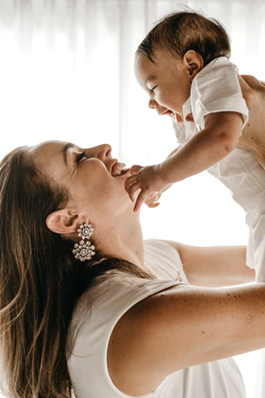11.5: Infant Vocal Development
- Page ID
- 140567
Vocal Development
The quality of infants’ vocalizations progresses markedly during the first year of life. From birth, infants produce reflexive vocalizations, such as cries, fusses, and vegetative noises (e.g., coughs, burps, sneezes), as well as prespeech (a.k.a. “protophone”) vocalizations (Buder, Warlaumont & Oller, 2013; Oller et al., 2009). Protophones are speech-like sounds including both canonical babbling (consisting of canonical syllables such as ‘ba’ or ‘da’ and sequences, ‘baba’ or ‘dada’ and so on) and non-canonical babbling (e.g. squeals, growls and vowel-like sounds). Infants produce approximately 3,500 protophone vocalizations every day (Oller et al., 2019). Infants begin cooing around two months of age. By three months of age, infants typically demonstrate an expanded range of vocal types, such as raspberries, squeals, growls, full vowels, yells, and whispers (Buder, Warlaumont & Oller, 2013; Oller, 2000). Between four to six months of age, infants begin to produce single syllable babbling sounds (e.g., da, ba) and then combine these syllable sounds (e.g., dadada, bababa) between six-eight months of age.[1] [2]

Babbling represents the specific sounds used in the language a child is exposed to. At around 7 months infants typically begin to demonstrate canonical babbling, which contains both consonants and vowels with swift transitions between them. Canonical babbling is considered speech-like and is a foundation for the first words that infants begin producing around the first birthday (Oller, 2000; Stoel-Gammon & Cooper, 1984). Cross-linguistic research shows that monolingual infants between 8 to 12 months of age begin to produce the characteristic intonation (Whalen, Levitt & Wang, 1991), syllable, and word-forms (Levitt & Utman, 1992; Levitt & Wang, 1991; Lleó, Prinz, El Mogharbel & Maldonado, 1996) of the specific language to which they are exposed, whether that be Spanish, Russian, Tagalog, a signed language or Arabic (Petitto & Marentette, 1991; Sundara, Ward, Conboy & Kuhl, 2020). Interestingly, frequency of early infant vocalizations is related to expressive language at twelve months of age (Lyakso, Frolova & Grigorev, 2014; Werwach, Mürbe, Schaadt & Männel, 2021). [1] [4]
While infants’ early vocalizations are important, it is the specific combination of infant vocalizations followed up by a caregiver response that is the strongest predictor of language growth (Donnellan et al., 2020). When caregivers respond to infants’ vocalization it creates a meaningful dyadic interaction that extends language learning. When caregivers do respond to the speech-like vocalizations from infants, infants are more likely to produce another speech-like vocalization, creating a language-rich interactional loop (Warlaumont, Richards, Gilkerson & Oller, 2014) that is positively related to later vocabulary development (Lopez, Walle, Pretzer & Warlaumont, 2020).
[1] Lopez et al., (2020). Adult responses to infant prelinguistic vocalizations are associated with infant vocabulary: A home observation study. PloS One, 15(11), e0242232.
[2] Oller, et al., (2021). Protophones, the precursors to speech, dominate the human infant vocal landscape. Philosophical Transactions of the Royal Society B, 376(1836), 20200255. CC by 4.0
[3] Image by Jonathan Borba on Unsplash.
[4] Sundara et al., (2020). Exposure to a second language in infancy alters speech production. Bilingualism: Language and Cognition, 23(5), 978-991. CC by 4.0

